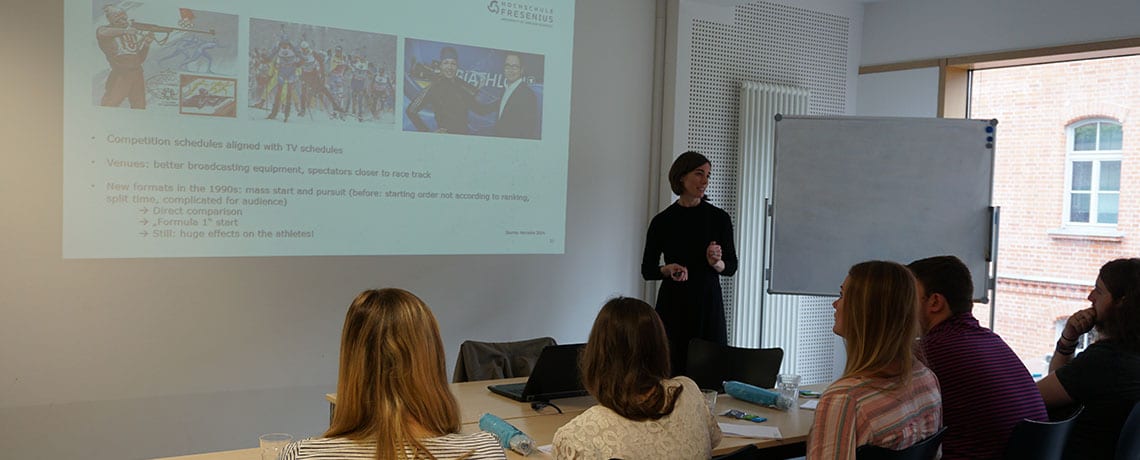
A&M Texas meets Hochschule Fresenius
Students from US University visit the Munich Campus and hear lecture on sports mediatisation.
The lecture was held by Prof. Dr. Stephanie Heinecke, Dean of Sport Management Studies in Munich and an expert in sports and media. She discussed how mediatisation can influence a sport, its viewership, popularity and overall success. To explain this phenomenon, the group firstly debated why sport contents are so popular among media consumers. According to the professor, there are several possible explanations: sport programmes are highly emotional and can usually be easily followed by viewers. In addition, they create a feeling of excitement and identification with different teams. For Germany, this applies in particular to men’s football. No other sport sparks greater interest: each year, football events provide for the top 20 TV contents, especially if a World or European Championship is taking place. Furthermore, the auction for broadcasting rights to Bundesliga or Champions League games play an important role on the TV market.
This, in turn, makes it difficult for less popular sports to establish themselves on the German media market: while they can reach their fan base through online streaming services, TV channels usually grant them only little broadcasting time, even though media and sports can be considered a “perfect match”: sponsors of sport clubs demand media presence which means that sport associations can benefit from public coverage. For TV stations, on the other hand, attractive sport content is an important asset to satisfy consumer needs and exclusive broadcasting rights constitute a strong advantage in comparison to competitors. In this context, the mediatisation of sport plays an important role: in detail, this means that sports are adapted to the needs of viewers and the media in order to increase telegenity which can lead to an increase in viewership as a result.
MEDIATISATION INCREASES VIEWERSHIP
There are several examples to support this theory, the most popular being biathlon. While the sport attracted almost no spectators during the Winter Olympics of 1984 in Sarajevo, it became widely popular in the 1990s due to a change of rules, namely, the introduction of mass starts and pursuits. This allowed athletes to race and shoot at the same time, rather than competing consecutively, which led to easier comparability and more excitement during the race for viewers. Mediatisation can also be observed in beach volleyball. Introducing a simple counting system and slowing down the game made it easier for the audience to follow the match. In addition, entertainment was increased by downsizing the beach volleyball court and changing some rules in order to promote spectacular moves by players, for example when trying to save the ball. Further examples for greater entertainment in sports are, according to Prof. Dr. Heinecke, the Superbowl Half Time Show, storytelling around rivalries in boxing, or group phases followed by knock-out games, as they can be found during the Football World Championship.
Prof. Dr. Heinecke concludes that media and sports will continue to depend on each other in the future. For example, winter sports currently have an ageing viewership, prompting the associations to develop ways to excite a younger audience for their sports. Furthermore, upcoming sectors like eSports are quickly and increasingly gaining sponsorship and were able to obtain TV coverage. It will be interesting to see if and how mediatisation can have a positive effect on these sports, especially considering that they have emerged in a digital media environment.
The US guests showed great interest in the topic and asked further questions concerning various sports in Germany. Thus, they were able to take with them a wide range of impressions and information to enrich their knowledge in the area of sport management.